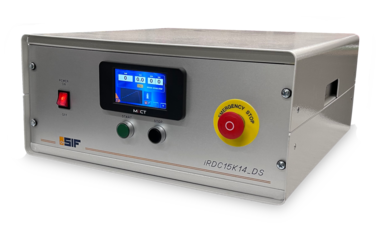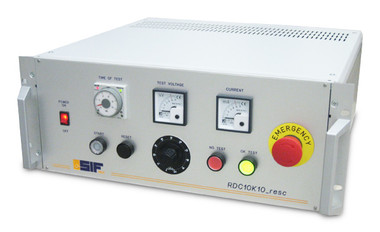
SIF presents a new system for high voltage direct current dielectric strength tests. The system is aimed at both electrical cable manufacturers and other sectors where this type of test is required.
DC equipment has the advantage of using a low-power generator.
The compact dimensions of the equipment allow it to be used both in the laboratory and near the production lines, while considering all aspects of operator safety.
The equipment is completely digital, with a 4.3” HMI color graphic touch screen for selecting the test and operating modes and for periodic calibrations and complete with an automatic discharger to ensure maximum operator safety,all as standard.
| MODELS | ||
|---|---|---|---|
Features | iRDC15K14_DS | iRDC15K08_DS | iRDC15K02_6S_DS |
Max. output voltage kV DC | 15 | 15 | 15 |
Max. output current mA | 14 | 8,3 | 2 |
Output voltage accuracy | ±(2%+50V) | ||
HV ramp setting | (0,25-0,5-1-2-5) kV/s | ||
Timer | 99 m 59 s | ||
Short circuit current | Adjustable | Adjustable | Adjustable |
Voltage supply | 230 V 50Hz | ||
Discharger at the end of the test | ✓ | ✓ | ✓ |
4 starting modes selection | ✓ | ✓ | ✓ |
4 testing modes selection | ✓ | ✓ | ✓ |
Automatic test cycle for 3-pole cables with or without connector |
|
| ✓ |
Contact for signaling external safety lights | ✓ | ✓ | ✓ |
External security input | ✓ | ✓ | ✓ |
Standards compliance | CEI EN IEC 61010-1, CEI EN 50191 | ||
1. AUTOMATIC – automatic test
2.MANUAL – manual test
3.BD – Break Down
4.BDS – Break Down Steps
5. 6S – 6 Steps - ONLY FOR iRDC15K02_6S_DS MODEL
Discharger: HV closing at test start, earthing closing at test end, test disconnection at the end of discharge
1. Independent START and STOP button – pressing the START button activates the test and, if the test does not stop automatically, pressing the STOP button interrupts the test
2. START button and STOP button to be pressed together – the START and STOP buttons must be pressed and held down until the end of the test. When you release the buttons the test stops.
3. Double external START button – Connect the two START buttons in the connector. Both external START buttons must be pressed and held down until the end of the test. When the buttons are released, the test stops.
4. External pedal button – You plug the button into the connector. Pressing the pedal activates the test and, if the test does not stop automatically, pressing the STOP button interrupts the test.

Equipment features: